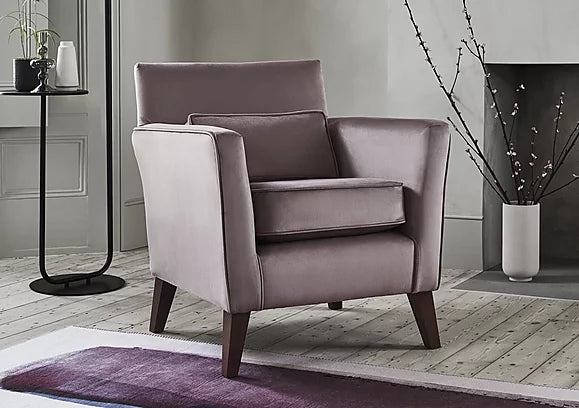- No products in the cart.
THE ULTIMATE GUIDE TO CHOOSING ACCENT CHAIRS THAT TRANSFORM YOUR SPACE
29
Jun
Accent chairs are not just additional seating—they are style statements, design focal points, and the secret sauce to a beautifully balanced room. Whether you’re decorating a living room, bedroom, reading nook, or hallway, the right accent chair has the power to elevate your space from ordinary to outstanding. These versatile furniture pieces blend form and function, offering comfort while expressing your personality.
This guide will walk you through everything you need to know about choosing the perfect accent chairs for any room in your home—from design types and upholstery options to styling tips and placement ideas.
What Is an Accent Chair?
An accent chair is a single-seat chair that adds visual interest to a room. Unlike your main sofa or couch, it’s often chosen for its standout colour, unique shape, or eye-catching fabric. Accent chairs serve both aesthetic and practical purposes: they provide extra seating while acting as a decorative piece that ties your room together.
The Key Benefits of Accent Chairs
1. Adds Character to a Room
Accent chairs inject personality into neutral or minimalist interiors. A boldly patterned or brightly coloured chair can bring life to a subdued palette.
2. Defines a Space
Use an accent chair to carve out specific zones in open-plan layouts. They help designate areas for reading, lounging, or conversation.
3. Offers Flexibility
Lightweight accent chairs can be moved easily, giving you flexibility when entertaining guests or rearranging furniture.
4. Enhances Comfort
Beyond aesthetics, they offer a cosy, inviting seat for you or your guests to unwind in.
Types of Accent Chairs: Finding Your Signature Style
Let’s explore the most popular types of accent chairs to help you choose the one that best suits your home and lifestyle:
1. Armchairs
Armchairs are classic accent chairs with built-in armrests. They're perfect for lounging and come in various styles—from traditional wingbacks to sleek mid-century modern designs.
Best for: Living rooms, reading corners, bedrooms.
2. Barrel Chairs
Barrel chairs feature a rounded back that wraps around the seat, resembling a barrel. They offer a cocoon-like comfort that’s ideal for relaxing.
Best for: Bedrooms, nurseries, quiet corners.
3. Slipper Chairs
These armless chairs sit low to the ground with a wide seat, offering a minimalist, elegant silhouette.
Best for: Small spaces, entryways, or rooms with limited seating space.
4. Wingback Chairs
Known for their high backs and side wings, these chairs exude sophistication and are perfect for formal spaces.
Best for: Offices, classic interiors, libraries.
5. Swivel Chairs
Modern and functional, swivel accent chairs offer rotation and often double as work chairs in home offices or living rooms.
Best for: Home offices, media rooms.
6. Lounge Chairs
Designed with comfort in mind, lounge chairs often come with matching ottomans and are ideal for stretching out and relaxing.
Best for: Reading nooks, TV rooms, bedroom corners.
Choosing the Right Material for Your Accent Chair
Upholstery plays a big role in both the look and functionality of an accent chair. Here’s a breakdown of popular materials:
Velvet
Soft, plush, and luxurious, velvet chairs make a statement and add rich texture to your space.
Best for: Glam interiors, luxurious lounges.
Leather
Durable and sophisticated, leather is ideal for high-traffic areas and offers a timeless appeal.
Best for: Offices, rustic or modern interiors.
Linen
Lightweight and breathable, linen offers a casual, breezy vibe perfect for relaxed living.
Best for: Coastal, Scandinavian, or country-style homes.
Cotton
Soft and versatile, cotton fabrics come in various prints and colours, making it easy to match any decor style.
Best for: Kids' rooms, casual spaces.
Synthetic Blends
Polyester or other blends are stain-resistant, affordable, and durable.
Best for: High-traffic areas, budget-conscious shoppers.
Size and Scale: Proportion Matters
When selecting accent chairs, consider their size in relation to your room and existing furniture. Oversized chairs may overpower a small room, while petite slipper chairs might feel lost in a large open space.
Tips for getting the size right:
-
Measure your space before buying.
-
Leave enough room around the chair for movement.
-
Make sure it complements the scale of your other furniture.
Colour and Pattern: Bold or Blended?
Accent chairs can either pop or blend, depending on your design goals.
Go Bold If:
-
You want to create a focal point.
-
Your existing decor is neutral or minimal.
-
You enjoy vibrant, eclectic styles.
Go Neutral If:
-
You’re layering textures and prefer harmony.
-
You want a timeless piece that adapts to changing decor.
-
Your room already has bold elements.
Where to Place Accent Chairs in Your Home
Here are some creative placement ideas to inspire you:
Living Room
Pair one or two accent chairs with a sofa to complete a seating area. Angle them to encourage conversation or position them facing a TV or fireplace.
Bedroom
Place an armchair by the window or at the foot of the bed. It’s perfect for reading or as a stylish spot to rest clothes or throw blankets.
Entryway
A slim slipper chair or barrel chair can make your entryway feel more inviting while offering a convenient place to put on shoes.
Dining Room
Mix in accent chairs at the ends of a dining table to create visual interest and a sense of hierarchy.
Office or Study
A wingback or leather chair adds authority and comfort to your work-from-home setup.
How to Style Your Accent Chairs
Here’s how to accessorize your accent chairs like a pro:
1. Throw Pillows:
Add a textured or patterned cushion for extra comfort and visual appeal.
2. Blankets or Throws:
A casually draped throw adds warmth and a lived-in look.
3. Accent Tables:
Pair your chair with a side table to create a functional reading nook.
4. Rugs:
Anchor the chair with a rug to define the space and add softness.
5. Lighting:
Place a floor lamp or table lamp nearby to enhance the ambiance.
Matching vs Mixing Accent Chairs
You don’t always need to buy a matching set. In fact, mixing different styles can create a layered and lived-in aesthetic.
When to Match:
-
If you want symmetry or a cohesive look.
-
For formal or minimalist spaces.
When to Mix:
-
To add depth and character.
-
For eclectic, boho, or modern interiors.
Tip: Stick to a common element like colour, scale, or shape to tie mismatched chairs together.
Accent Chairs for Different Interior Design Styles
Let’s explore the best accent chair picks for popular design styles:
Modern
Think clean lines, metal or wood accents, and minimalist upholstery like leather or solid cotton.
Mid-Century Modern
Go for tapered legs, muted colours, and retro silhouettes.
Bohemian
Look for patterned fabrics, textured materials, and eclectic designs.
Farmhouse
Opt for distressed wood, plaid or linen fabric, and curved arms.
Industrial
Metal frames, leather finishes, and raw materials like wood or iron suit this rugged style.
Glam
Velvet fabrics, gold legs, and tufted backs are perfect for adding glitz and elegance.
Care Tips for Keeping Accent Chairs Looking Great
Keep your accent chairs in tip-top shape with these easy care practices:
Regular Cleaning:
Vacuum the fabric regularly to remove dust and debris.
Spot Clean Spills:
Act quickly with a damp cloth and mild soap for stains.
Protect from Sunlight:
Avoid placing fabric chairs in direct sunlight to prevent fading.
Rotate Placement:
Switch up their location every few months to avoid uneven wear.
Check Legs and Joints:
Tighten screws and check for any signs of wobbling or damage.
Budgeting for Accent Chairs: What to Expect
Accent chairs are available at a wide range of prices depending on size, materials, craftsmanship, and brand reputation.
Affordable:
$50–$200 — Ideal for student apartments, guest rooms, or temporary decor.
Mid-Range:
$200–$600 — Best for most households looking for durability and design.
High-End:
$600+ — Investment pieces with premium materials, custom options, or designer appeal.
Common Mistakes to Avoid When Buying Accent Chairs
-
Ignoring measurements: Always check dimensions before purchase.
-
Clashing styles: Choose chairs that complement your space, not compete with it.
-
Overlooking comfort: Sit in it if possible—looks aren’t everything!
-
Forgetting function: Think about how it will be used (daily seating vs. decorative).
-
Buying without a plan: Consider placement, usage, and coordination with your existing decor.
Elevate Your Interior with the Perfect Accent Chair
Whether you want to add charm to your entryway, create a reading nook in your bedroom, or simply update your living room’s aesthetic, accent chairs offer a versatile and impactful solution. With endless styles, materials, and placement possibilities, there's an accent chair for every home and every personality.
Investing in the right accent chair is more than just buying furniture—it’s about expressing your taste, enhancing comfort, and transforming your space. So go ahead and find that perfect piece that speaks to you.
Each room in your home serves a unique purpose, and your accent chair should reflect that. Here's a room-by-room guide to making the best choice:
Living Room
This is where style meets function. Choose a chair that complements your sofa but doesn’t blend in too much. A slightly contrasting fabric or shape will make your accent chair stand out while still feeling part of the overall design.
Recommended features:
-
Sturdy frame for daily use
-
Comfortable cushions
-
Neutral tones or bold hues depending on your décor
Bedroom
Accent chairs in bedrooms should invite relaxation. Think of them as mini-retreats within your personal haven. Soft fabrics and ergonomic shapes work best.
Recommended features:
-
Soft upholstery (velvet, cotton, linen)
-
Cozy shape (barrel, slipper, or small armchair)
-
Small footprint
Home Office
In a workspace, an accent chair adds polish and gives visitors a comfortable place to sit. A refined, upright design is usually best.
Recommended features:
-
Supportive back
-
Leather or high-quality fabric
-
Clean lines to keep it professional
Dining Room
Accent chairs at the ends of a table add depth and distinction. They can be slightly taller, with arms, and upholstered to increase formality.
Recommended features:
-
Durable fabric
-
Comfortable seat height
-
Arms optional, depending on table clearance
Nursery
A calm, comfortable chair is essential. Choose an accent chair that rocks or swivels if possible.
Recommended features:
-
Easy-to-clean fabric
-
Gentle motion options
-
Supportive for feeding or cuddling
Eco-Friendly Accent Chairs: A Sustainable Choice
Sustainability is no longer a trend—it's a priority. Many accent chairs are now made with eco-conscious materials and practices. Here's what to look for if you're going green:
-
Recycled Materials: Look for upholstery or stuffing made from recycled fibres.
-
Sustainable Wood: FSC-certified wood ensures responsible forestry.
-
Low-VOC Finishes: These reduce harmful chemicals in your home.
-
Durability: Long-lasting chairs reduce the need for frequent replacements.
Choosing sustainable accent chairs not only benefits the planet but also brings natural, earthy textures and tones into your home.
Accent Chairs for Small Spaces
Even the tiniest apartment or studio can benefit from a well-chosen accent chair. The key is to prioritise compact designs without compromising style.
Top picks for small spaces:
-
Slipper Chairs: Their armless design saves space.
-
Folding Accent Chairs: Easily tuck them away when not in use.
-
Transparent Acrylic Chairs: Visually light and modern.
-
Corner Chairs: Designed to nest perfectly into corners.
Tips:
-
Use vertical space—add floating shelves above the chair.
-
Choose multifunctional designs like chairs with hidden storage.
-
Go for lighter colours to create a sense of openness.
Accent Chair Trends: What’s In Right Now
Like all furniture, accent chairs follow trends. Here are the hottest styles currently dominating interior design:
1. Curved Silhouettes
Soft, rounded shapes are in—offering a sculptural, high-design look that also feels inviting.
2. Bouclé Fabric
This cozy, textured fabric has taken over minimalist interiors for its aesthetic and comfort.
3. Bold Colours
Emerald green, rust orange, and mustard yellow are popping up in modern homes.
4. Mixed Materials
Think wood and metal frames paired with soft cushions—combining rustic and industrial.
5. Statement Legs
Tapered, gold, or artfully angled legs add flair to even the most understated chairs.
Pairing Accent Chairs with Other Furniture
Creating a cohesive look requires more than just a pretty chair. Here’s how to pair your accent chair with existing pieces for maximum impact:
With a Sofa
-
Match tones or fabrics for unity.
-
Use contrast for visual interest (e.g., leather sofa + velvet chair).
With a Coffee Table
-
Mind proportions—avoid placing a large chair with a tiny table.
-
Round tables work well with curved chair backs.
With a Side Table
-
Height matters—ensure the table is level with or slightly lower than the chair’s armrest.
-
Use it to hold a lamp, plant, or cup of tea.
With a Rug
-
Choose a rug large enough to sit all legs of the chair on or just the front two.
-
Patterns should complement rather than compete with the chair’s upholstery.
Creating a Reading Nook with an Accent Chair
A well-designed reading corner can turn into your favourite part of the home. Here's how to curate the perfect space:
1. Choose the Right Chair
Look for support, softness, and a shape that lets you settle in. Lounge or barrel chairs are excellent choices.
2. Add a Lamp
Place a warm-toned lamp nearby to create a soothing atmosphere.
3. Include Storage
Add a small shelf or a stack of books with a decorative tray.
4. Use Soft Layers
Throw pillows, fuzzy rugs, and blankets create a warm, inviting vibe.
5. Position Near Natural Light
Place your nook near a window if possible—it’s great for mood and practicality.
How Many Accent Chairs Should You Have?
There’s no one-size-fits-all answer, but here are a few guidelines to help:
-
Small Living Rooms: One accent chair is often enough.
-
Larger Spaces: Two matching or complementary chairs can provide symmetry and balance.
-
Open Floor Plans: You may use multiple accent chairs across different zones to tie the space together.
Just be careful not to overcrowd—accent chairs are meant to stand out, not be squashed in.
FAQs About Accent Chairs
Q: Can accent chairs be used daily?
Yes! Just choose materials and frames designed for everyday use if they’ll be used often.
Q: Do all rooms need an accent chair?
Not necessarily. Use them to enhance rooms that feel empty or lack a personal touch.
Q: How do I mix different accent chairs in one room?
Choose chairs that differ in shape or colour but share one unifying element, like material or style.
Q: What is the ideal height for an accent chair?
Most are 16–18 inches from floor to seat. Always check the height of nearby furniture to maintain harmony.
Final Words: Why Accent Chairs Deserve Your Attention
Accent chairs are more than mere furniture—they’re transformative pieces that offer style, comfort, and function in one smart package. Whether you're redecorating your entire home or simply adding a finishing touch, the right accent chair makes all the difference.
From bold statement pieces to quiet, calming designs, these chairs are the unsung heroes of interior design. They blend seamlessly or stand out proudly. They support conversations, morning coffee moments, evening reads, and everything in between.
Choosing the right accent chair is about more than just ticking boxes—it's about enhancing the way you live, feel, and express yourself in your home.
So go ahead. Sit down. Stay a while. Let your accent chair tell your story.














